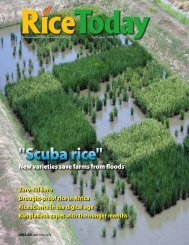How much water does rice need? - adron.sr
How much water does rice need? - adron.sr
How much water does rice need? - adron.sr
Create successful ePaper yourself
Turn your PDF publications into a flip-book with our unique Google optimized e-Paper software.
Investingin the futureby Sushil Pandey, Mark W. Rosegrant,Timothy Sulser, and Humnath Bhandari<strong>How</strong> will future investment inagriculture affect <strong>rice</strong> p<strong>rice</strong>s?P<strong>rice</strong> index (year 2000 = 100)350Investment scenario300ReferenceLow250200HighVery high1501005002000 2025 2050YearRice is a staple crop of Asia,which is home to almost 700million poor people withincome of less than a dollar aday. A confluence of several long- andshort-term factors led to a skyrocketingp<strong>rice</strong> of <strong>rice</strong> in early 2008.Keeping the p<strong>rice</strong> of <strong>rice</strong>affordable for the poor is criticallyimportant for poverty reduction. Theshare of <strong>rice</strong> in total expenditureof poor households is estimated at30–50%. Any substantial rise in thep<strong>rice</strong> of <strong>rice</strong>, therefore, is equivalentto a substantial drop in real income.Using the International Modelfor Policy Analysis of AgriculturalCommodities and Trade (IMPACT) 1to make long-term projections, weestimated <strong>rice</strong> p<strong>rice</strong>s out to 2025and 2050 under three alternativescenarios of investments in and policyoptions for agricultural research anddevelopment. These were comparedwith a reference scenario representing“business as usual” (see figure).The Low scenario presentsa pessimistic view of futuredevelopments in agriculturalproduction around the world and afurther reduction in already decliningrates of investment in agriculturalresearch and development. Incontrast, the optimistic High scenariohas governments and other agenciesprioritizing agricultural investmentsto improve productivity, particularlyin the developing world. The Veryhigh scenario augments the improvedHigh situation with increasedinvestments in yield improvements,intensification of existing agriculturalsystems, increased investment inirrigation infrastructure, as well ashigher investment in other povertyandmalnutrition-reducing strategies.Under the Business as usualreference scenario, the p<strong>rice</strong> of<strong>rice</strong> will increase almost 50% by2025, and will continue to increase,although at a slower pace, from2025 to 2050. The Low scenario isextremely unfavorable. Were thisscenario to become reality, <strong>rice</strong> p<strong>rice</strong>sin 2050 would be nearly double theprojected reference scenario p<strong>rice</strong>sand triple the 2000 starting p<strong>rice</strong>.The more optimistic scenarios are<strong>much</strong> more promising. By 2050,<strong>rice</strong> p<strong>rice</strong>s would actually declinerelative to the starting year. The Highscenario would see <strong>rice</strong> p<strong>rice</strong>s abouthalf those of the projected referencevalue. The Very high scenario wouldresult in 2050 p<strong>rice</strong>s of roughly athird of the reference scenario p<strong>rice</strong>s.In short, <strong>rice</strong> p<strong>rice</strong>s willbe lower in 2050 relative to2000 only if investments inagricultural technology, research,and development are boostedsubstantially (the High and Veryhigh scenarios). Such investmentsare necessary <strong>rice</strong> productivity toincrease rapidly enough to keepp<strong>rice</strong>s down.The underlying cause of thecurrent <strong>rice</strong> crisis is a long-termimbalance between demand andsupply: production growth hasTrends in <strong>rice</strong> p<strong>rice</strong> under reference (businessas-usual)and three alternative policy scenarios,2000-50. These long-term projections do not factorin short-term supply shocks and trade restrictions ofthe kind that prompted p<strong>rice</strong> spikes in early 2008.Source: IFPRI IMPACT model projection, April 2008failed to keep pace with demandgrowth. As the root of the problemis on the supply side, the long-termsolution will require measures toboost production. These measurescan be grouped into two categories:stimulating investments in research,technology, and infrastructure, andpolicy reforms.Although <strong>rice</strong> p<strong>rice</strong>s have droppedfrom their peak in May 2008, they arestill high relative to 2007 levels and arelikely to remain too high for millionsof poor. The task ahead is challengingbut not insurmountable and requiresa substantial boost for agriculturalresearch, which remains highlyunderinvested. Increased investmentstogether with policy reforms that make<strong>rice</strong> markets more efficient will providethe ultimate solution to the <strong>rice</strong> crisis.Drs. Pandey and Bhandari areagricultural economists at IRRI.Drs. Rosegrant and Sulser areagricultural economists at theInternational Food Policy ResearchInstitute. This article is based onRice p<strong>rice</strong> crisis: causes, impacts,and solutions, a paper presented atthe 6th International Conference ofthe Asian Society of AgriculturalEconomists, Manila, Philippines, 28-30 August 2008.1Rosegrant MW, Msangi S, Ringler C, Sulser TB, Zhu T, Cline SA. 2008. International Model for Policy Analysis of Agricultural Commodities andTrade (IMPACT): Model Description. Washington, D.C. (USA): International Food Policy Research Institute.Rice Today January-March 200941

















